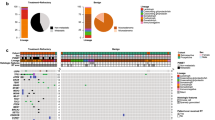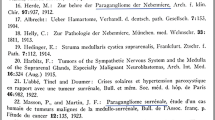Abstract
Purpose
The expression of glucose transporter-1 (Glut-1) gene and those of major thyroid-specific genes were examined in papillary carcinoma tissues, and the expressions of these genes were compared with cancer differentiation grades.
Materials and Methods
Twenty-four human papillary carcinoma tissues were included in this study. The expressions of Glut-1- and thyroid-specific genes [sodium/iodide symporter (NIS), thyroid peroxidase, thyroglobulin, TSH receptor and pendrin] were analyzed by RT-PCR. Expression levels were expressed as ratios versus the expression of beta-actin. Pathologic differentiation of papillary carcinoma was classified into a relatively well-differentiated group (n = 13) and relatively less differentiated group (n = 11).
Results
Glut-1 gene expression was significantly higher in the less differentiated group (0.66 ± 0.04) than in the well-differentiated group (0.59 ± 0.07). The expression levels of the NIS, PD and TG genes were significantly higher in the well-differentiated group (NIS: 0.67 ± 0.20, PD: 0.65 ± 0.21, TG: 0.74 ± 0.16) than in the less differentiated group (NIS: 0.36 ± 0.05, PD: 0.49 ± 0.08, TG: 0.60 ± 0.11), respectively. A significant negative correlation was found between Glut-1 and NIS expression, and positive correlations were found between NIS and TG, and between NIS and PD.
Conclusion
The NIS, PD and TG genes were highly expressed in well-differentiated thyroid carcinomas, whereas the Glut-1 gene was highly expressed in less differentiated thyroid carcinomas. These findings provide a molecular rationale for the management of papillary carcinoma, especially in the selection of FDG PET or radioiodine whole-body scan and I-131-based therapy.





Similar content being viewed by others
References
Taurog A. Hormone synthesis. In: Braverman LE, Utigen RD eds. The thyroid: a fundamental and clinical text. Philadelphia: Lippincott-Raven; 1996: p. 47–81.
Ros P, Rossi DL, Acebron A, Santisteban P. Thyroid-specific gene expression in the multi-step process of thyroid carcinogenesis. Biochimie. 1999;81:389–96.
Chung JK, Lee YJ, Kim C, et al. Mechanism related to [18 F]fluorodeoxyglucose uptake of human colon cancers transplanted in nude mice. J Nucl Med. 1999;40:339–46.
Haber RS, Weiser KR, Pritsker A, Reder I, Burstein DE. Glut-1 glucose transporter expression in benign and malignant thyroid nodules. Thyroid. 1997;7:363–7.
Schonberger J, Ruschoff J, Grimm D, Marienhagen J, Rummele P, Meyringer R, et al. Glucose transporter 1 gene expression is related to thyroid neoplasms is related with an unfavorable prognosis: an immunohistochemical study. Thyroid. 2002;12:747–54.
Matsuzu K, Segade F, Matsuzu U, Carter A, Bowden DW, Perrier ND. Differential expression of glucose trnasporters in normal and pathologic thyroid tissue. Thyroid. 2004;14:806–12.
Chung JK, So Y, Lee JS, Choi CW, Lim SM, Hong SW, et al. Value of FDG PET in papillary thyroid carcinoma with negative 131I whole-body scan. J Nucl Med. 1999;40:986–92.
Wang W, Macapinlac H, Larson SM, Yeh SD, Akhurst T, Finn RD, et al. [18F]-2- fluoro-2-deoxy-D-glucose positron emission tomography localizes residual thyroid cancer in patients with negative diagnostic 131I whole body scans and elevated serum thyrolgobulin levels. J Clin Endocrinol Metab. 1999;84:2291–302.
Carrasco N. Iodide transport in the thyroid gland. Biochim Biophys Acta. 1993;1154:65–82.
Chung JK. Sodium iodide symporter: its role in nuclear medicine. J Nucl Med. 2002;43:1188–200.
Chung JK, Kang JH. Translational research using the sodium iodide symporter in imaging and therapy. Eur J Nucl Med Mol Imaging. 2004;31:799–802.
Lazar V, Bidart B, Caillou C, Mahe C, Macroix L, Filett S, et al. Expression of the Na+/I- symporter gene in human thyroid tumors: a comparison study with other thyroid specific genes. J Clin Endocrinol Metab. 1999;84:3228–334.
Hedinger C, Williams ED, Sobin LH. Histological typing of thyroid tumours. Word Health Organization International Histological Classification of Tumours. Berlin: Springer Verlag; 1988. ISBN 2.
Ponte P, Ng SY, Engel J, Gunning P, Kedes L. Evolutionary conservation in the untranslated regions of actin mRNAs: DNA sequence of a human beta-actin cDNA. Nucleic Acids Res. 1984;31:1687–96.
Malthie´ryiry Y, Lissitzky S. Primary structure of human thyroglobulin deduced from the sequence of its 8448-base complementary DNA. Eur J Biochem. 1987;165:491–8.
Liebert F, Ruel J, Ludgate M, Swillens S, Alexander N, Vassart ZG, et al. Complete nucleotide sequence of the human thyroperoxidase-microsomal antigen cDNA. Nucleic Acids Res. 1987;15:6735.
Nagayama Y, Kaufman KD, Seto P, Rapoport B. Molecular cloning, sequence and functional expression of the cDNA for the human thyrotropin receptor. Biochem Bioph Res Co. 1989;165:1184–90.
Porra V, Bernier-Valentin F, Trouttet-Masson S, et al. Characterization and semiquantitative analyses of pendrin expressed in normal and tumoral human thyroid tissues. J Clin Endocrinol Metab. 2002;87:1700–7.
Robbins J, Merino MJ, Boice Jr JD, Ron Em Ain KB, Alexander HR, et al. Thyroid cancer: a lethal endocrine neoplasm. Ann Intern Med. 1991;115:133–47.
Cartro MR, Bergert ER, Goellner JR, Hay ID, Morris JC. Immunohistochemical analysis of sodium iodide symporter expression in metastatic differentiated thyroid cancer: Correlation with radioiodine uptake. J Clin Endocrinol Metab. 2001;86:5624–32.
Min JJ, Chung JK, Lee YJ, Jeong JM, Lee DS, Jang JJ, et al. Relationship between expression of the sodium/iodide symporter and 131I uptake in recurrent lesions of differentiated thyroid carcinoma. Eur J Nucl Med. 2001;28:639–45.
Patel A, Jhiang S, Dogra S, Terrell R, Powers PA, Fenton C, et al. Differentiated thyroid carcinoma that express sodium-Iodide symporter have a lower risk of recurrence for children and adolescents. Pediatr Res. 2002;52:737–44.
Ward LS, Santarosa PL, Granja F, Assumpcao LVM, Savoldi M, Goldman GH. Low expression of sodium iodide symporter identifies aggressive thyroid tumors. Cancer Lett. 2003;200:85–91.
Gerard AC, Daumerie C, Mestdagh C, Cohy C, De Burbure C, Costagliola S, et al. Correlation between the loss of thyroglobulin iodination and the expression of thyroid-specific proteins involved in iodine metabolism in thyroid carcinomas. J Clin Endocrinol Metab. 2003;88:4977–83.
Arturi F, Russo D, Bidart JM, Scarpelli D, Schlumberger M, Filetti S. Expression pattern of the pendrin and sodium/iodide symporter genes in human thyroid carcinoma cell lines and human thyroid tumors. Eur J Endocrinology. 2001;145:129–35.
Tanaka K, Otsuki T, Sono H, Yamamoto Y, Udagawa K, Kunisue H, et al. Semiquantitative comparison of the differentiation markers and sodium iodide symporter messenger ribonucleic acids in papillary thyroid carcinomas using RT-PCR. Eur J Endocrinology. 2000;142:340–6.
Feine U, Lietzenmayer R, Hanke JP, Held J, Wohrle H, Muller-Schuenburg W. Fluorine-18-FDG and iodine-131-iodide uptake in thyroid cancer. J Nucl Med. 1996;37:1468–72.
Grunwald F, Menzel C, Bender H, Palmero H, Willkomm P, Ruhlmann J, et al. Comparison of 18FDG-PET with 131iodine and 99mTc-sestamibi scintigraphy in differentiated thyroid cancer. Thyroid. 1997;7:327–35.
Johnson TL, Lloyd RV, Thompson NW, Beierwaltes WH, Sisson JC. Prognostic implications of the tall cell variant of papillary thyroid carcinoma. Am J Surg Pathol. 1988;12:22–7.
Mizukami Y, Noguchi M, Michigishi T, Nonomura A, Hashimoto T, Otakes S, et al. Papillary thyroid carcinoma in Kanazawa, Japan: prognostic significance of histological subtypes. Histopathology. 1992;20:243–50.
Berho M, Suster S. The oncocytic variant of papillary carcinoma of the thyroid: a clinicopathologic study of 15 cases. Hum Pathol. 1997;28:47–53.
Albareda M, Puig-Domingo M, Wengrowicz S, Solderila J, Matias-Guiu X, Caballero A, et al. Clinical forms of presentation and evolution of diffuse sclerosing variant of papillary carcinoma and insular variant of follicular carcinoma of the thyroid. Thyroid. 1998;8:385–91.
Acknowledgments
This study was supported by the Seoul National University Hospital Research Fund (grant no. 03-2004-013-0) and a grant from the Korean Health Technology R&D Project, Ministry of Health, Welfare & Family Affairs, Republic of Korea (A070001), and a grant from Korea University (grant no. K1132631 and K0714991).
Conflict of Interest
Sungeun Kim, June-Key Chung, Hae-Sook Min, Joo-Hyun Kang, Do Joon Park, Jae Min Jeong, Dong Soo Lee, Sung-Hwae Park, Bo Youn Cho, Sinae Lee and Myung Chul Lee declare no conflict of interest.
Author information
Authors and Affiliations
Corresponding author
Rights and permissions
About this article
Cite this article
Kim, S., Chung, JK., Min, HS. et al. Expression Patterns of Glucose Transporter-1 Gene and Thyroid Specific Genes in Human Papillary Thyroid Carcinoma. Nucl Med Mol Imaging 48, 91–97 (2014). https://doi.org/10.1007/s13139-013-0249-x
Received:
Revised:
Accepted:
Published:
Issue Date:
DOI: https://doi.org/10.1007/s13139-013-0249-x




